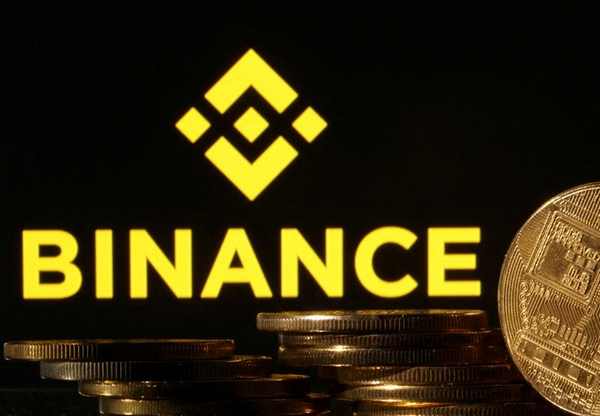-
 Bitcoin
Bitcoin $93,580.5822
5.99% -
 Ethereum
Ethereum $1,780.3758
12.27% -
 Tether USDt
Tether USDt $1.0000
0.02% -
 XRP
XRP $2.2336
7.45% -
 BNB
BNB $617.0092
2.58% -
 Solana
Solana $151.1010
8.49% -
 USDC
USDC $0.9998
-0.01% -
 Dogecoin
Dogecoin $0.1804
11.02% -
 Cardano
Cardano $0.6935
10.66% -
 TRON
TRON $0.2473
-0.16% -
 Chainlink
Chainlink $14.5597
11.46% -
 Sui
Sui $2.9078
29.47% -
 Avalanche
Avalanche $22.5900
14.68% -
 UNUS SED LEO
UNUS SED LEO $9.0735
-1.25% -
 Stellar
Stellar $0.2674
9.14% -
 Shiba Inu
Shiba Inu $0.0...01364
10.52% -
 Toncoin
Toncoin $3.1063
6.26% -
 Hedera
Hedera $0.1842
6.84% -
 Bitcoin Cash
Bitcoin Cash $361.7446
7.08% -
 Polkadot
Polkadot $4.0610
9.37% -
 Litecoin
Litecoin $83.8579
6.50% -
 Hyperliquid
Hyperliquid $18.8944
3.48% -
 Bitget Token
Bitget Token $4.6004
4.14% -
 Dai
Dai $0.9999
0.01% -
 Ethena USDe
Ethena USDe $0.9993
0.01% -
 Pi
Pi $0.6699
6.47% -
 Monero
Monero $227.1589
5.14% -
 Pepe
Pepe $0.0...09056
14.37% -
 Uniswap
Uniswap $5.9024
12.54% -
 Aptos
Aptos $5.2984
10.41%
How to operate Binance contract
To effectively operate Binance Contract, traders should master its interface, fund their accounts, choose appropriate trading pairs and order types, determine leverage levels, monitor positions, manage risk, and continuously enhance their knowledge.
Nov 09, 2024 at 06:32 am

How to Operate Binance Contract
Binance Contract, a sophisticated trading platform offered by Binance, enables traders to engage in futures contracts trading with leverage. Understanding the intricacies of operating Binance Contract is essential for maximizing its potential and managing risks effectively.
1. Familiarize Yourself with Binance Contract Interface
Before engaging in any trading activities on Binance Contract, it is crucial to navigate the platform's interface. Locate the "Derivatives" tab on the Binance homepage and select "USDT-M Futures." This section provides a comprehensive overview of available futures markets, order types, and charting tools.
2. Fund Your Binance Contract Account
To initiate trading on Binance Contract, you must transfer funds from your Binance spot wallet to your contract account. Click on the "Wallet" tab and navigate to "Funding." Select "Transfer" and specify the amount you wish to transfer from your spot wallet to your contract account.
3. Choose the Right Trading Pair
Binance Contract offers a wide range of futures contracts based on different cryptocurrencies. Choose the trading pair you are interested in by clicking on its corresponding ticker symbol, such as BTCUSDT for Bitcoin futures or ETHUSDT for Ethereum futures.
4. Select an Order Type
Binance Contract provides various order types to suit different trading strategies. The most common types include:
- Limit Order: Set a specific price at which you want to buy or sell the contract.
- Market Order: Execute the order immediately at the current market price.
- Stop-Limit Order: Create a conditional order that triggers a limit order when the market price reaches a specified level.
- Stop-Market Order: Create a conditional order that triggers a market order when the market price reaches a specified level.
5. Determine Leverage
Leverage allows you to magnify your potential profits by borrowing funds from the exchange. Binance Contract offers variable leverage levels, typically ranging from 1x to 125x. However, it is crucial to use leverage responsibly as it also amplifies potential losses.
6. Place Your Order
Once you have identified your trading strategy, selected the order type, and determined the leverage, you can place your order. Input the desired quantity of the contract, review the order details, and click on "Buy" or "Sell" to execute the trade.
7. Monitor Your Position
After placing an order, you can monitor its status in the "Positions" tab. This section provides real-time updates on your open positions, including current price, profit/loss, and margin usage. Monitor your positions closely to manage risk and adjust your strategy as needed.
8. Adjust or Close Your Position
Depending on market conditions and your trading strategy, you may need to adjust or close your position. To adjust, you can modify the stop-loss and take-profit orders associated with your position. To close your position, click on the "Close Position" button in the "Positions" tab.
9. Manage Risk Effectively
Binance Contract trading involves significant risk due to the use of leverage. It is essential to implement robust risk management strategies, such as setting realistic profit/loss targets, using stop-loss orders, and monitoring your margin usage.
10. Enhance Your Knowledge
Continuously educate yourself about futures contracts trading, market analysis techniques, and risk management principles. Join trading communities, attend webinars, or explore reputable educational resources to gain insights and improve your trading skills.
Disclaimer:info@kdj.com
The information provided is not trading advice. kdj.com does not assume any responsibility for any investments made based on the information provided in this article. Cryptocurrencies are highly volatile and it is highly recommended that you invest with caution after thorough research!
If you believe that the content used on this website infringes your copyright, please contact us immediately (info@kdj.com) and we will delete it promptly.
- Bitcoin (BTC) rose from Tuesday’s low of $88,000 to above $93,500 in Asian morning hours
- 2025-04-23 14:45:12
- 5 Best Free Cloud Mining Websites to Make Money Bitcoin and Dogecoin in 2025
- 2025-04-23 14:45:12
- MiL.k Partners with Galxe to Expand Network and Connect Korean Users to Global Web3 Ecosystem
- 2025-04-23 14:40:13
- Trump Media and Technology Group Ventures into the World of Finance
- 2025-04-23 14:40:13
- AI-Driven Token Projects Are Poised to Revolutionize the World of Finance by 2025
- 2025-04-23 14:35:13
- Cantor Fitzgerald, SoftBank, and Tether Team Up to Form a Bitcoin Investment Vehicle
- 2025-04-23 14:35:13
Related knowledge

How does Tail Protection reduce the loss of liquidation?
Apr 11,2025 at 01:50am
Introduction to Tail Protection in CryptocurrencyTail Protection is a mechanism designed to mitigate the risks associated with liquidation in cryptocurrency trading. Liquidation occurs when a trader's position is forcibly closed by the exchange due to insufficient margin to cover potential losses. This often happens in leveraged trading, where traders b...

What are the consequences of an imbalance in the long-short ratio?
Apr 13,2025 at 02:50pm
The long-short ratio is a critical metric in the cryptocurrency trading world, reflecting the balance between bullish and bearish sentiments among traders. An imbalance in this ratio can have significant consequences on the market dynamics, affecting everything from price volatility to trading strategies. Understanding these consequences is essential fo...

How to judge the market trend by the position volume?
Apr 11,2025 at 02:29pm
Understanding how to judge the market trend by position volume is crucial for any cryptocurrency trader. Position volume, which refers to the total number of open positions in a particular cryptocurrency, can provide valuable insights into market sentiment and potential price movements. By analyzing this data, traders can make more informed decisions ab...

Why does a perpetual contract have no expiration date?
Apr 09,2025 at 08:43pm
Perpetual contracts, also known as perpetual futures or perpetual swaps, are a type of derivative product that has gained significant popularity in the cryptocurrency market. Unlike traditional futures contracts, which have a fixed expiration date, perpetual contracts do not expire. This unique feature raises the question: why does a perpetual contract ...

Why is the full-position mode riskier than the position-by-position mode?
Apr 13,2025 at 03:42pm
Why is the Full-Position Mode Riskier Than the Position-by-Position Mode? In the world of cryptocurrency trading, the choice between full-position mode and position-by-position mode can significantly impact the risk profile of a trader's portfolio. Understanding the differences between these two modes is crucial for making informed trading decisions. Th...

How is the liquidation price calculated?
Apr 12,2025 at 01:35am
Introduction to Liquidation PriceLiquidation price is a critical concept in the world of cryptocurrency trading, particularly when dealing with leveraged positions. Understanding how this price is calculated is essential for traders to manage their risk effectively. The liquidation price is the point at which a trader's position is forcibly closed by th...

How does Tail Protection reduce the loss of liquidation?
Apr 11,2025 at 01:50am
Introduction to Tail Protection in CryptocurrencyTail Protection is a mechanism designed to mitigate the risks associated with liquidation in cryptocurrency trading. Liquidation occurs when a trader's position is forcibly closed by the exchange due to insufficient margin to cover potential losses. This often happens in leveraged trading, where traders b...

What are the consequences of an imbalance in the long-short ratio?
Apr 13,2025 at 02:50pm
The long-short ratio is a critical metric in the cryptocurrency trading world, reflecting the balance between bullish and bearish sentiments among traders. An imbalance in this ratio can have significant consequences on the market dynamics, affecting everything from price volatility to trading strategies. Understanding these consequences is essential fo...

How to judge the market trend by the position volume?
Apr 11,2025 at 02:29pm
Understanding how to judge the market trend by position volume is crucial for any cryptocurrency trader. Position volume, which refers to the total number of open positions in a particular cryptocurrency, can provide valuable insights into market sentiment and potential price movements. By analyzing this data, traders can make more informed decisions ab...

Why does a perpetual contract have no expiration date?
Apr 09,2025 at 08:43pm
Perpetual contracts, also known as perpetual futures or perpetual swaps, are a type of derivative product that has gained significant popularity in the cryptocurrency market. Unlike traditional futures contracts, which have a fixed expiration date, perpetual contracts do not expire. This unique feature raises the question: why does a perpetual contract ...

Why is the full-position mode riskier than the position-by-position mode?
Apr 13,2025 at 03:42pm
Why is the Full-Position Mode Riskier Than the Position-by-Position Mode? In the world of cryptocurrency trading, the choice between full-position mode and position-by-position mode can significantly impact the risk profile of a trader's portfolio. Understanding the differences between these two modes is crucial for making informed trading decisions. Th...

How is the liquidation price calculated?
Apr 12,2025 at 01:35am
Introduction to Liquidation PriceLiquidation price is a critical concept in the world of cryptocurrency trading, particularly when dealing with leveraged positions. Understanding how this price is calculated is essential for traders to manage their risk effectively. The liquidation price is the point at which a trader's position is forcibly closed by th...
See all articles
























































































